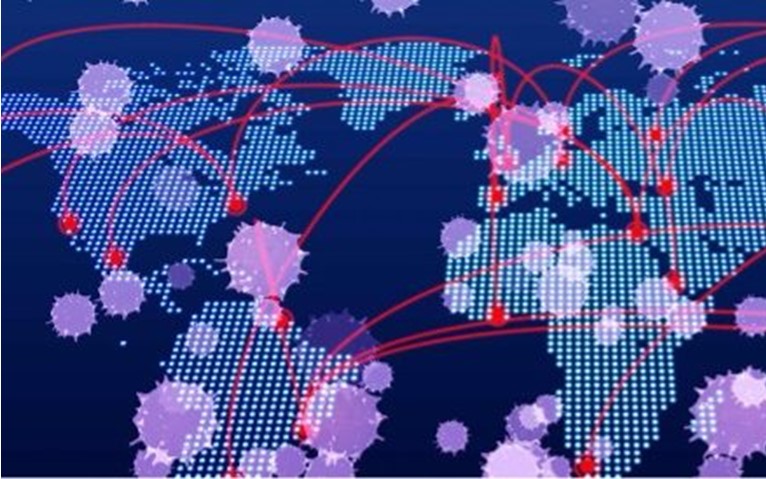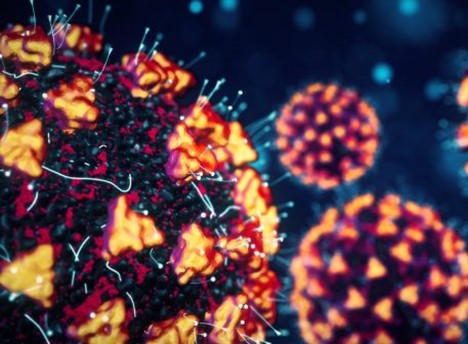|
March 2021 NORTHWESTERN MEDICINE SCIENTISTS TRACK COVID-19 VARIANTSFeaturing: Ramon Lorenzo-Redondo, PhD; Egon Ozer, MD, PhD, ‘08, ‘12 GME; Judd Hultquist, PhD; Lacy Simons; Michael Ison, MD, MS; Chad Achenbach, ’02 MD, ’02 MPH and Alan Hauser, PhD. Lindsay Morrison, MD
Like all viruses, SARS-CoV-2 — the virus that causes COVID-19 — has continued to mutate and evolve, sometimes producing different variants that spread more quickly and are more contagious. Since March 2020, a team of Northwestern Medicine scientists based in the Division of Infectious Diseases and supported by the Emerging and Re-emerging Pathogens Program (EREPP) have been tracking the evolution of SARS- CoV-2, specifically in the city of Chicago. Their work has been pivotal in understanding how the virus spread to Chicago and what new variants have emerged in the city. In January 2021, the Chicago Department of Public Health and the Illinois Department of Public Health announced that the team had found Illinois’ first case of a SARS-CoV-2 variant that was originally identified in the U.K., called B.1.1.7. Evidence suggests that this variant, which was first detected in the U.S. in December 2020, spreads more easily and quickly than other known variants. In early March 2021, the team also identified the first case of the COVID-19 variant first identified in Brazil, called P.1. The variant, which was first identified in the U.S. in January, has several mutations in the virus’ notorious spike protein, including one shared with the U.K. variant. Research suggests that the variant’s additional mutations may affect its ability to be recognized by antibodies. However, it is still unclear whether either variant causes more severe disease. “It’s important to stay ahead of the game and know which strains are emerging, where they are emerging and what the implications of the new mutations are. These are all critical tools for public health departments to plan their interventions,” said Babafemi Taiwo, MBBS, ’06 GME, the Gene Stollerman Professor of Medicine and chief of Infectious Diseases. The team working on tracking the virus includes Ramon Lorenzo-Redondo, PhD; Egon Ozer, MD, PhD, ‘08, ‘12 GME; Judd Hultquist, PhD; Lacy Simons; Michael Ison, MD, MS; Chad Achenbach, ’02 MD, ’02 MPH and Alan Hauser, PhD. Lindsay Morrison, MD, a current fellow in the Department of Infectious Diseases, and former fellows Scott Roberts, MD, and Hannah Nam, MD, also contributed to the team’s research. Always on the Lookout Viruses have one main goal: to replicate themselves by mutating and spreading to as many hosts as possible as quickly as possible. This process, however, is error-prone — when a virus copies its genetic material inside host cells, it will generate many errors, most of them neither helping nor hurting the virus. However, there are certain instances when a mutation may actually improve a virus’ ability to infect and replicate, ultimately leading to a new variant of the virus. “We are always going to see viruses evolving and changing because that’s just in their nature,” Lorenzo-Redondo said. “Sometimes a mutation might be so advantageous in a specific environment that it generates what is called a ‘bottleneck’ in the population and the genetic characteristics of this improved mutant get transmitted to the next generations, generating a new viral lineage. If this mutation makes the viruses much better at infecting or replicating than other lineages already present, this new lineage might be able to expand or even take over the viral population. That’s how some of these biologically relevant variants might have appeared.” Shortly after the first case of COVID-19 was identified in the U.S., the research team applied for Institutional Review Board approval to obtain residual diagnostic tests from patients at Northwestern Memorial Hospital and from patients who received COVID-19 testing at Northwestern Medicine’s outpatient centers. To date, they have collected more than 6,000 positive COVID-19 samples from across the city. With the samples secured, the team immediately got to work. The samples were first sorted and banked by Simons and Hultquist, who then extracted viral RNA from each sample, converted it into DNA and amplified it by polymerase chain reaction (PCR). Next, the team led by Ozer used deep sequencing approaches to determine and assemble entire genome sequences of the viruses isolated from each patient. These sequences were then analyzed by Lorenzo-Redondo using phylogenetics, a method which incorporates clinical and geographical data to build family trees of the virus in order to understand the forces behind its evolution. From this data, the team was able to trace the origins of the virus in the Chicago area and identify new, circulating variants. This approach enabled them to identify the U.K. variant of the virus in the city and alert local and state public health departments. Contract tracing performed by the Chicago Public Health Department would later reveal that the person who tested positive for the strain had traveled to the U.K. and the Middle East two weeks prior to testing positive. “This makes Chicago a very interesting place to study the virus because it has one of the most connected airports in the world,” Lorenzo-Redondo said. By the end of May 2020, the team had compiled a comprehensive dataset of genetic sequencing information from samples obtained at Northwestern Memorial Hospital. This dataset is now publicly available for use by the greater scientific community and public health departments around the world. The team is also working to create two additional biobanks with the samples: a collection of serial blood samples from COVID-19 patients and a collection of serial SARS-CoV-2 samples from infected patients. According to the team, these biobanks will be essential for tracking the virus as it continues to evolve inside the host. In addition, these resources will enable investigators to better understand how current and emerging variants respond to treatments, and what immune responses and biomarkers may indicate certain patient outcomes. An Ongoing Race At the beginning of the pandemic, there was no pre-existing immunity to the virus and so it simply evolved to infect faster and better. Now, because more and more people have immunity to the virus, either due to vaccination or previous infection, the virus is pressured to adapt and evade immunity all together. “What this is telling us is that we are allowing the virus to become better by replicating, generating diversity and selecting mutations.”Lorenzo-Redondo said. “We need to lower the prevalence of the virus because if not, the virus is going to keep evolving.” In addition to lowering the number of COVID-19 cases, constantly monitoring known and emerging variants is critical to ensure public health measures are continuously updated and most effective. The team is also partnering with other groups locally, nationally and internationally so genomic sequencing of SARS-CoV-2 and its variants can be widely adopted. “The concern here is that eventually you’ll end up with a strain that’s no longer going to be protected against by the vaccine, that’s the long-term concern,” Hultquist said. “The problem is we have no way of predicting exactly when a variant like that could.” That’s why vaccinating as much of the general population as soon as possible is so important, Hultquist said. Currently, there are three COVID-19 vaccines approved by the Food and Drug Administration for authorized use: mRNA vaccines from Pfizer-BioNTech and Moderna, each requiring two separate doses, and the most recently approved one-dose viral vector vaccine from Johnson & Johnson. While each vaccine differs in technology and efficacy, new research suggests that they may be less effective in protecting against some variants of COVID-19. The good news, Hultquist said, is that these vaccines can be updated by the manufacturer to be more responsive to new variants if they arise, similar to how the flu vaccine is updated annually. One thing that is certain, however: the same safety measures used to contain COVID-19 — including handwashing, masking and social distancing — will work against known and emerging variants. “These variants can’t be more easily transmitted or overcome a vaccine or the immune system if it never gets to you in the first place,” Ozer said. “We have to continue to take these precautions for now regardless of what variants come next.” This article was originally published in the Feinberg School of Medicine News Center on March 23, 2021. |
Ramon Lorenzo-Redondo, PhD, research assistant professor of Medicine in the Division of Infectious Diseases.
Egon Ozer, MD, PhD, ‘08, ‘12 GME, assistant professor of Medicine in the Division of Infectious Diseases.
Judd Hultquist, PhD, assistant professor of Medicine in the Division of Infectious Diseases.
Refer a PatientNorthwestern Medicine welcomes the opportunity to partner with you in caring for your patients.
|
You May Also Like
|
December 2020 |







